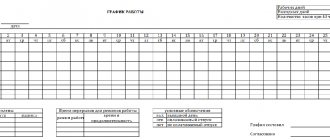What is a work schedule
Labor legislation provides for standardized or irregular working hours for employees. It is established by internal labor regulations, collective agreements, agreements, and employment contracts.
Normal working hours include the following work schedule:
- 5-day week with 2 days off;
- 6 days with 1 day off;
- a week with days off on a rotating schedule or a part-time work week.
Labor standards specify what employee work schedules are. The main types are:
- single shift;
- weekly;
- sliding;
- removable;
- shift worker, etc.
In case of irregular working hours, a shift schedule is established for some categories of employees. This is a document that is established in accordance with Art. 103 of the Labor Code of the Russian Federation and is introduced when the duration of the production process exceeds the working time of the employee.
In production, groups of employees replace each other, and in order to ensure continuity of the process, it becomes necessary to work or provide services around the clock. To keep their working hours within the norm, shift schedules are introduced. Usually they are annexed to the collective agreement, and when approved, the opinion of the representative body of workers is taken into account.
IMPORTANT!
Micro-enterprises have the right to include a shift schedule in the employment contract with the employee. Write down the work schedule and rest time in this format (part 2 of article 57, part 1 of article 100, part 1 of article 104, article 107, 108 of the Labor Code of the Russian Federation):
- length of the working week;
- beginning, end and duration of work shifts, number of shifts per day;
- alternating working days and weekends;
- time of breaks, their duration;
- accounting period, if summarized working time accounting is maintained.
ConsultantPlus experts discussed how to create a work schedule during shift work. Use these instructions for free.
to read.
Types of work schedules and their features
The main types of graphs include:
- standard or single shift;
- removable or sliding;
- flexible or traveling;
- irregular;
- shift worker;
- fragmented.
The choice of one option or another depends on the direction of the enterprise’s work, for example, if we are talking about equipment that should not stop.
In some cases, schedules are drawn up based on individual convenience for workers. For example, if someone lives in another city, then it is more convenient for him to be at the enterprise for two weeks and at home for two.
Shift work schedule
A shift schedule is established at enterprises where the duration of the organization’s activities significantly exceeds one permissible shift.
For example, if a cafe is open around the clock, then a person is physically unable to work all twenty-four hours.
Such companies have an eight-hour shift schedule, and during one day three employees work at the same place.
There is a 2-by-2 work schedule - this is when a person works for two days in a row for several hours, and then rests for the next two days. The same thing happens with the graphs 5 after 2, 4 after 2, a day after three and others.
According to Article One Hundred and Ten of the Labor Code of the Russian Federation, people’s weekly rest cannot be less than forty-two hours. In this regard, people work several shifts, but out of all the hours in a week, they are required to rest for a set period.
The most difficult form is day/night + 48 hours of rest. A person only has time to work and sleep; there is not enough time for anything else.
Single shift schedule
A regular schedule of eight hours at work is most common.
It is divided into several types of accounting:
- by days;
- by week.
As for the standard types of production time distribution, in most cases the following choices are provided:
- Five days and two days off, usually Saturday and Sunday, or other options 5 through 2.
- A six-day week with one day off, most often a floating one, that is, 6 through 1.
The presented regimes are fixed in the hundredth article of the Labor Code.
Another available option is cumulative time tracking. It is used when a daily or weekly calendar is not suitable, for example, during construction work or during the activities of truck drivers.
It is worth noting: in practice, the working day ranges from eight to twelve hours. Although this is not regulated at the legislative level.
Flexible schedule
Flexible scheduling is a relatively new employment system, which was primarily aimed at helping women with small children find a job.
The key feature is a clearly defined number of hours in the template that employees must work for a specific period, but without specifying the start and end times of the work shift.
This form of work is secured by an additional order attached to the employment contract. The specifics, period and number of hours depend on the personal agreement between the employer and employee.
Irregular schedule
Irregular working hours are allowed in a number of enterprises, and this possibility is stipulated in the employment contract, for example, in a store.
With such a system, personnel work as usual, but at the direction of the manager they can be involved in activities beyond the established schedule.
Additional time can be either after the shift or before it. According to the law, employment can only occur for those duties that are specified in the employment agreement.
For example, forcing a manager to clean the enterprise if this item is not specified in the contract is unacceptable.
Shift work schedule
Shift work is established in companies and enterprises where it is impossible for employees to return home every day.
This method is most common when carrying out construction work, in particular in uninhabited areas and remote regions.
Accommodation for employees is organized either directly at the workplace or in special villages and buildings. As a rule, the rotational work schedule is made for one or several weeks, sometimes for a month.
People are rarely busy for more than a month, but the shifts last no more than 12 hours.
What are the differences from a time sheet?
It is necessary to distinguish the document recording the working hours from the timesheet of hours worked, which is maintained by the employer in accordance with the requirements of Art. 91 of the Labor Code of the Russian Federation and is a kind of document recording working hours for the month. The norm is 40 working hours per week. The employer is obligated to keep records of actual time worked for each employee.
There are no special requirements for familiarization with the report card within a certain period and there is no need to coordinate it with the representative body of employees. The employer can only not exceed the established duration of the working day and provide workers with rest in accordance with the requirements of Art. 110 Labor Code of the Russian Federation.
Keeping timesheets is mandatory for any organization. But with a continuous flow, when people work in shifts, a working time schedule is required. In both cases, it is necessary to specify in the employment contract all the specifics in the section that concerns the working hours.
Results
The working time schedule contains information about the standard working hours, the number of days off and working days, the boundaries and duration of the working day, as well as the combination of working periods with rest periods.
The work schedule in 2021 is largely similar to similar schedules in previous years. As in 2021, the current year is characterized by a standard set of weekends/holidays (118 days), but there are 1 fewer working and calendar days than last year.
Sources: Labor Code of the Russian Federation
You can find more complete information on the topic in ConsultantPlus. Free trial access to the system for 2 days.
Why do you need a work schedule?
Its functions are quite diverse. It is required for:
- streamlining employee work time;
- calculating wages when fulfilling specific obligations;
- calculating average earnings;
- benefit calculations;
- determining the employee’s insurance length;
- absence of errors in determining earnings and compensation for vacation (together with the working time sheet, it is the basis for calculating wages and other payments);
- identifying overtime overtime and determining additional payments.
After approval, the team is introduced to the schedule for signature one month before commissioning. If a signature is refused, a special act is drawn up with the signatures of two witnesses. Failure to comply with the established regime is a serious disciplinary offense.
Working time schedule for 2021 (timesheet): how to fill it out
There are two unified forms: T-12 and T-13. The difference between them is that the T-12 form is filled out only manually or in a text editor, and it has a special section for calculating wages. Timesheet T-13 can be filled out using specialized computer programs and access control systems, which are used to record visits by company employees to their work. This form does not have a block for calculating wages; it must be calculated in other registers.
The time sheet is the primary document on the basis of which employees’ wages, payments from them and additional payments accepted in the organization are calculated. Since the listed payments reduce corporate income tax or taxable income under the simplified tax system, the document should be fixed as a primary document in the organization’s accounting policy. It is not necessary to use the unified form from 01/01/2013. It is important to consolidate your own version of the form in the accounting policy and ensure that it contains all the necessary details, the mandatory presence of which for primary documents is established by law 402-FZ.
The time sheet is drawn up in one copy by a person authorized to monitor the control of working hours throughout the organization or in a separate structural unit. The list of persons signing it is established by the internal administrative act of the organization. At the end of each month, the completed timesheet is transferred to the accounting department.
Let's look at the procedure for filling out the timesheet using the T-13 form as an example.
The name of the organization and structural unit must be filled in the header (when monitoring working hours in structural units). The serial number is assigned in accordance with the accepted numbering in the organization. The date of compilation and the reporting period must be filled in as details of the primary document.
You can download a sample work schedule in Excel at the end of the article. Now let’s look at how to calculate a work schedule and draw it up correctly.
Is there a required form?
There is no unified form: each employer has the right to independently develop its own document form or use a ready-made template. Instructions on how to make a work schedule for a month in Excel or any other editor:
- Prepare a database to fill out: indicate the name and registration information of the organization.
- List all employees and their positions.
- Mark the days on which each employee comes to work.
Develop the document in such a way as to prevent shortcomings or rework beyond normal working hours and ensure optimal workload on the team and on production processes. The schedule is most often developed for a month.
Filling procedure
The general rules for creating a schedule are simple. Here's how to create a duty schedule for a month in the form of a table without errors:
- Fill out the document taking into account the working hours in accordance with the internal labor regulations in force in the organization. Indicate the beginning and end, duration of the working day, breaks, number of shifts, alternation of work and rest.
- Keep track of the length of the working day. The duration is regulated by internal regulations, taking into account the working time regime established by the employment contract.
- If necessary, provide for a shorter working day, as, for example, in industries with harmful and dangerous conditions (Part 4 of Article 94 of the Labor Code of the Russian Federation) or when the work of disabled people and minors takes place (Parts 1, 3 of Article 94 of the Labor Code of the Russian Federation) .
Where and how long is it stored?
Order No. 236 of Rosarkhiv dated December 20, 2019 established the storage periods for personnel documentation. Clause 8.1 of Section II of the order states that books, journals, accounting cards and databases are stored for 5 years. When working with difficult, harmful and dangerous working conditions, the shelf life is set at 75 years or 50 years if the document was completed after 01/01/2003.
There is no specific reference in the order regarding how long to keep the work schedule. Still, some employers prefer to store such documents for a year in the human resources or accounting department in case of a labor dispute with an employee regarding the issue of standardization of working hours or payroll.







